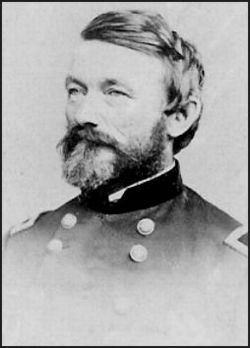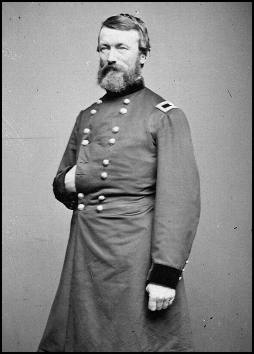Nathaniel J. Jackson facts for kids
Quick facts for kids
Nathaniel James Jackson
|
|
|---|---|

Nathaniel James Jackson
|
|
| Born | July 28, 1818 Newburyport, Massachusetts |
| Died | April 21, 1892 (aged 73) Jamestown, New York |
| Place of burial |
Oak Hill Cemetery, Newburyport, Massachusetts
|
| Allegiance | United States of America Union |
| Service/ |
United States Army Union Army |
| Years of service | 1861–1865 |
| Rank | |
| Commands held | 1st Maine Infantry Regiment 5th Maine Infantry Regiment 1st Division, XX Corps |
| Battles/wars | American Civil War |
Nathaniel James Jackson (born July 28, 1818 – died April 21, 1892) was an American inventor and a brave soldier. He became a general in the Union Army during the American Civil War. He was hurt three times in battles. After the war, he worked with mines.
Contents
Early Life and Work
Nathaniel J. Jackson was born in Newburyport, Massachusetts, a town by the sea. When he was young, he learned how to be a machinist. This means he learned to build and fix machines. By 1861, he was in charge of a large factory called the Hill mill in Lewiston, Maine.
Jackson was also part of the Maine State Militia. This was like a local army. He led some of these militia members early in the Civil War.
Serving in the Civil War
In 1861, Jackson decided to fight for the Union. The Union was the northern states during the Civil War. On May 3, he became a Colonel and led the 1st Maine Infantry. This group served for 90 days. After their time was up, Jackson left the army in August.
Returning to the Army
Jackson joined the Union Army again on September 3, 1861. He became the colonel of the 5th Maine Infantry. This time, the soldiers signed up for three years. Not everyone was happy about Jackson leading them. Some officers even quit. General Henry W. Slocum had to step in to stop more problems.
Battles and Injuries
Jackson and the 5th Maine then fought in the 1862 Peninsula Campaign. He was part of the Battle of Gaines' Mill on June 27. During this battle, Jackson was shot in his right elbow. His regiment lost many men. Ten were killed, 69 were wounded, and 16 went missing.
After he got better, Jackson fought in the 1862 Maryland Campaign. He was at the Battle of Crampton's Gap on September 14. Three days later, he was also at the Battle of Antietam. On September 19, Jackson was shot in his knee during more fighting at Crampton's Gap.
On September 23, Jackson wrote a report about the battle on September 14:
Around 3:30 p.m., we were told to move forward. We formed the first line of attack. Our position was on the left side. We immediately moved forward to attack the enemy. When we were about 500 yards away, we started fighting the enemy's soldiers. We stayed behind a rail fence for over an hour. Then, we ran out of bullets. We moved back a short distance. After that, we were ordered to attach bayonets and charge the enemy, which we did very quickly. We stayed on the battlefield all night. Both the officers and the men acted bravely. We lost 4 killed and 28 wounded.
Jackson was promoted to brigadier general on September 24, 1862. In October, he was given command of a group of soldiers in the XII Corps. This group was part of the Army of the Potomac. His group was stationed at Harper's Ferry during the Battle of Fredericksburg in December.
On April 17, 1863, Jackson was badly hurt in Spotsylvania County, Virginia. His horse slipped, and Jackson broke his right thigh bone. This injury meant he could not fight in the Battle of Chancellorsville in May. He was out of action until the fall.
Later War Service
When Jackson was well enough for light work, he was put in charge of a Draft Depot. This was a place where new soldiers were gathered. It was in New York Harbor on Rikers Island and later on Hart's Island. He held these jobs for over a year.
On November 11, 1864, Jackson was sent to the Western Theater. This was the western part of the war. He was given temporary command of a large group of soldiers called a division. This division was part of the XX Corps in the Army of Georgia. He led them during Sherman's March to the Sea in November and December 1864. During this march, Jackson was shot just above his right ankle.
In 1865, he continued to lead his division in the Carolinas Campaign. He fought at the Battle of Bentonville until April 2. On March 15, Jackson was given the honorary rank of major general. This was because of his brave actions at the Battle of Gaines' Mill almost three years earlier.
After the War
Jackson left the army on August 24, 1865, and went back to his normal life. By 1870, he had left Lewiston, Maine. After the war, he also worked as a coal mine operator.
Jackson died in the spring of 1892 in Jamestown, New York. He passed away at the home of one of his sons. His body was brought back to Massachusetts and buried in Newburyport. It was noted that local newspapers did not report on his death.
Images for kids



